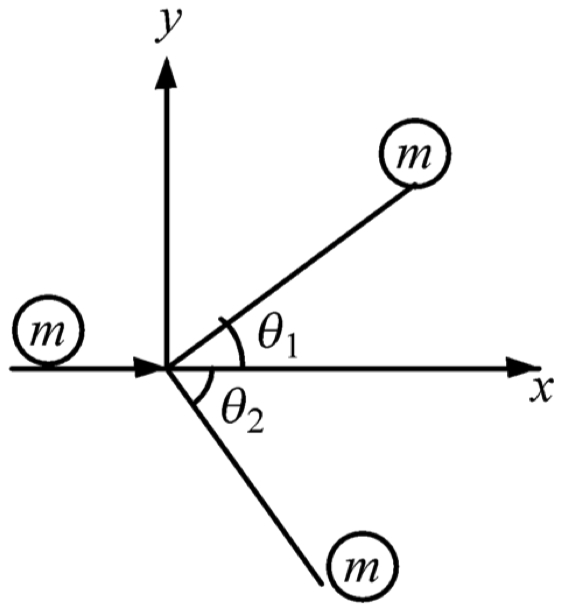Chapter 8
Question 1
A - Calculate the momentum of a
B - Compare the elephant’s momentum with the momentum of a
Calculate elephant's momentum
Comparison = Ratio = Division
C - What is the momentum of the 90.0\ kg hunter running at
Question 3
A - At what speed would a
B - What is the plane’s momentum when it is taking off at a speed of
C - If the ship is an aircraft carrier that launches these airplanes with a catapult, discuss the implications of your answer to (b) as it relates to recoil effects of the catapult on the ship.
Airplanes Momentum =
Ships Momentum =
The ships momentum is 3 powers of 10 larger than the airplanes (
Equation 8.30
Conservation of Momentum
If we apply this to the principle of recoil :
the momentum forces now are going in opposite directions
so lets say airplane = positive direction
and catapult / ship = negative direction
Ok , but instead of momentum directly , we break it down to mass times velocity again.
We can just rearrange that equation to let us solve for the "recoil" velocity
First though , we have to go back to question 2 , and get the mass off the ship
Finally we can plug everything in to the "recoil" equation :
They say this recoil velocity is very small and not noticeable if you were standing on the ship
Question 15 - A cruise ship with a mass of
Time it took to bring the ship to rest :
X-Axis Displacement =
Average Velocity =
Time Interval =
Impulse, or change in momentum, equals the average net external force multiplied by the time this force acts:
Calculate Initial Momentum :
Calculate net force
The pier was at rest , so it experiences this as
Question 23 - Train cars are coupled together by being bumped into one another. Suppose two loaded train cars are moving toward one another, the first having a mass of
Equation 8.53
We modify this though to just a single final velocity of the cars together :
Algebra
Rearrange to solve for final velocity
Question 25 - Consider the following question: A car moving at
This is the book's answer to the conceptual part :
In a collision with an identical car, momentum is conserved.
Afterwards
The change in momentum will be the same as in the crash with the tree.
However, the force on the body is not determined since the time is not known.
A padded stop will reduce injurious force on body.
Question 31 - A
A - Calculate the average force exerted on the ball by the bumper.
B - How much kinetic energy in joules is lost during the collision?
C - What percent of the original energy is left?
Question 44
A - During an ice skating performance, an initially motionless
B - How much kinetic energy is gained by this maneuver?
Calculate
Calculate
Finally ,
C - Where does the kinetic energy come from?
Book Answer :
The clown does work to throw the barbell ,
so the kinetic energy comes from the muscles of the clown.
The muscles convert the chemical potential energy of ATP into kinetic energy.
Question 45 - Two identical pucks collide on an air hockey table. One puck was originally at rest.
A - If the incoming puck has a speed of

Let
Therefore ,
Conservation of Momentum in X-Direction :
Equation 8.62
Conservation of Momentum in Y-Direction :
Equation 8.67
Combining the two equations :
First solve Equation 8.67 for
We can simplify though , because both hocky pucks are identical in mass
So just let
Lets make the same simplification of the masses for Equation 8.62 , and rewrite it in terms of
Now we can use these
Using Wolfram Alpha to simplify :
Calculate final velocity of one of the pucks
Finally solve for final velocity of the other hockey puck :
B - Confirm that the collision is elastic
Need to check if kinetic energy is conserved during the collision
total kinetic energy before and after the collision has to be the same
Calculate
they didn't give us a mass , but we can ignore it anyways because the mass doesn't change from initial to final state
Calculate
KE final and initial have equal values , therefore the collision is perfectly elastic.